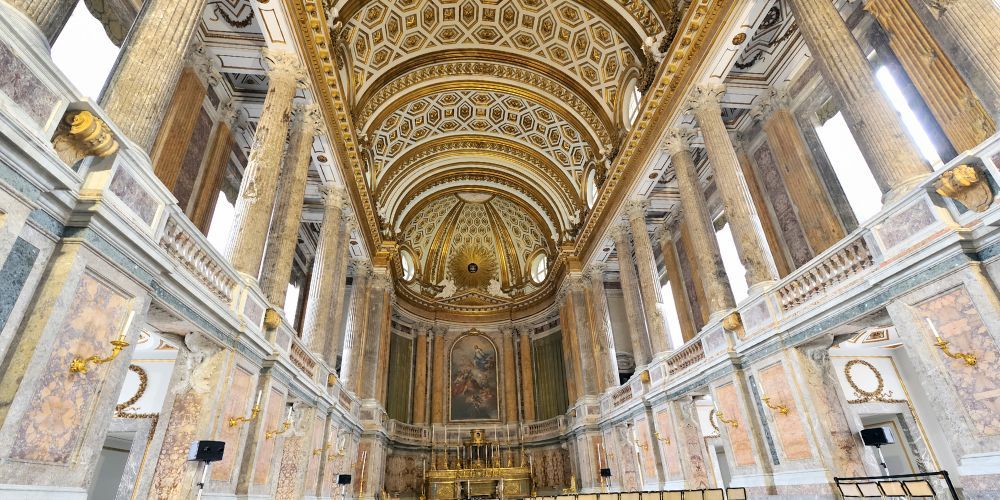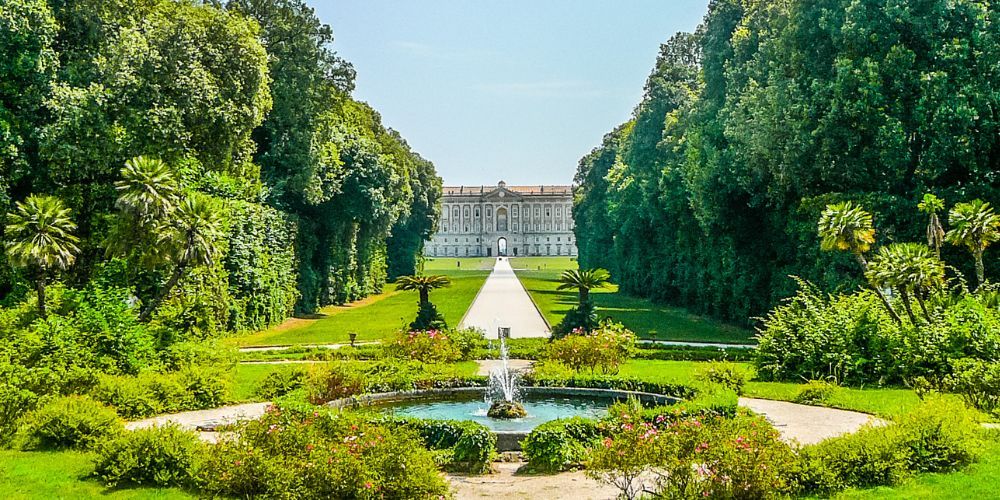Twelve hundred rooms, an immense park, an English garden and then fountains, waterfalls, statues. The Royal Palace of Caserta, UNESCO heritage and Baroque masterpiece, is the Italian Versailles commissioned by Charles of Bourbon, king of Naples, future Charles III of Spain, and designed by one of the most important architects of the time: Luigi Vanvitelli.
A grandiose work, that for its beauty, imponence and importance, is second to none of the other royal palaces in Europe. A place where you can get lost among the magnificence of art and the wonders of the landscapes, just a handful of kilometers from Naples.
Why to visit the Royal Palace of Caserta

It could be said that the Royal Palace of Caserta is the palace of records. Perhaps less famous than others, it nevertheless boasts staggering numbers.
With its five floors and forty-seven thousand square meters of total extension, it is the largest royal residence in the world. It took thirty years to complete the work, which not even its author was able to see completed. The project was in fact finished by Carlo Vanvitelli, son of Luigi, with other even more additions in the following decades.
There were around three thousand workers involved, and the total expense was exorbitant even for a king. It is estimated that today it would amount to more than four hundred million euros.
Also worth visiting because despite the unquestionable opulence of the marbles, gilded stuccos, frescoes and velvets, this building is an example of elegance where baroque, neoclassical and Renaissance coexist in harmony. Also thanks to its style and atmosphere, the Royal Palace of Caserta has also been the set of important movies, such as Angels and Demons or Star Wars.
Royal Palace of Caserta, what's its history?

On 20 January 1752, King Charles of Bourbon' birthday, began the construction of the sovereign's new residence, part of a bigger plan that changed the whole territory forever. The king wanted a palace worthy of rivaling those of Versailles or Schönbrunn, and chose the fiefdom of Caserta because, compared to Naples, it was less exposed to attacks from the sea.
The person in charge of the work was Luigi Vanvitelli, who arrived specifically from Rome, where he was also involved in the works at St. Peter's Basilica, "loaned" to the king by Pope Benedict XIV. The project was nothing short of grandiose. In addition to the park, it also included the
elliptical square in front of the building, from which a long avenue was supposed to lead directly to Naples, which was only partially built. However, one of the major engineering works of the 18th century was completed, the
Carolino aqueduct which was supposed to supply the palace. It's thirty-eight kilometers long and created on the model of the ancient Roman aqueducts.
Between epidemics, slowdowns due to the death of Vanvitelli and the fact that King Charles himself left Naples for the throne of Spain in 1759, the works lasted a few decades, and definitely finished only in 1845.
Royal Palace of Caserta: what to see

Visiting the Royal Palace of Caserta you will immediately realize that you are in a special place. The main entrance, for example, is the beginning of a very long perspective view which, crossing the entire ground floor, through the so-called telescope gallery, continues uninterruptedly in a straight line through the park, for almost five kilometers in total length.
In the left wing there is the court theatre, with the typical horseshoe plan, five tiers of boxes, and the ceiling decorated with pure gold inserts; the visit to the sumptuous royal apartments, however, begins right in the center of the Palace. Here is the spectacular grand staircase that leads to the upper floor where the largest room in the building, the throne room, is located. Don't miss the rooms of Mars, that of Astrea and those of the Four Seasons, where the elegance and sumptuousness of the furnishings will not leave you indifferent. The library commissioned by Queen Maria Carolina is also amazing, and includes two reading rooms, three consultation rooms and houses fourteen thousand volumes.
The grand staircase also gives access to the Palatine Chapel, for which the king wanted "the most beautiful marbles in the kingdom" and Vanvitelli chose bright colors which constitute one of the distinctive features of this church, where mass is still said on Sundays even today.
The park of the Royal Palace of Caserta

The huge park of the Royal Palace of Caserta, as we know it today, is a simplified version compared to the original project. Despite this, it is an incredible place, riche with things to see.
The first part is an Italian garden, with avenues that draw rigid geometries which on the eastern side lead towards the city of Caserta, while on the western side lead to the Bosco Vecchio, a woods. Here are a small octagonal castle complete with a moat, and the fishpond, a rather large artificial lake.
Continuing along the central avenue, the walk goes on for several hundred meters on the Via dell'Acqua. Here, the avenue runs along the side of very long pools with a highly elongated rectangular shape, interspersed with sculptures and small waterfalls, culminating in one of the most beautiful places in the entire park, the fountain of Diana and Actaeon. Behind the rich sculptural group, inspired by Ovid's Metamorphoses, there is a steep cliff from which the waters of a spectacular waterfall flow.
From this point you can also access the large
English garden, on the east side. Twenty-five hectares of land give home to countless botanical species, small buildings, archaeological ruins inspired by the excavations of
Pompeii and even a small bamboo forest.
How to visit the Royal Palace of Caserta: useful info















Lascia un commento